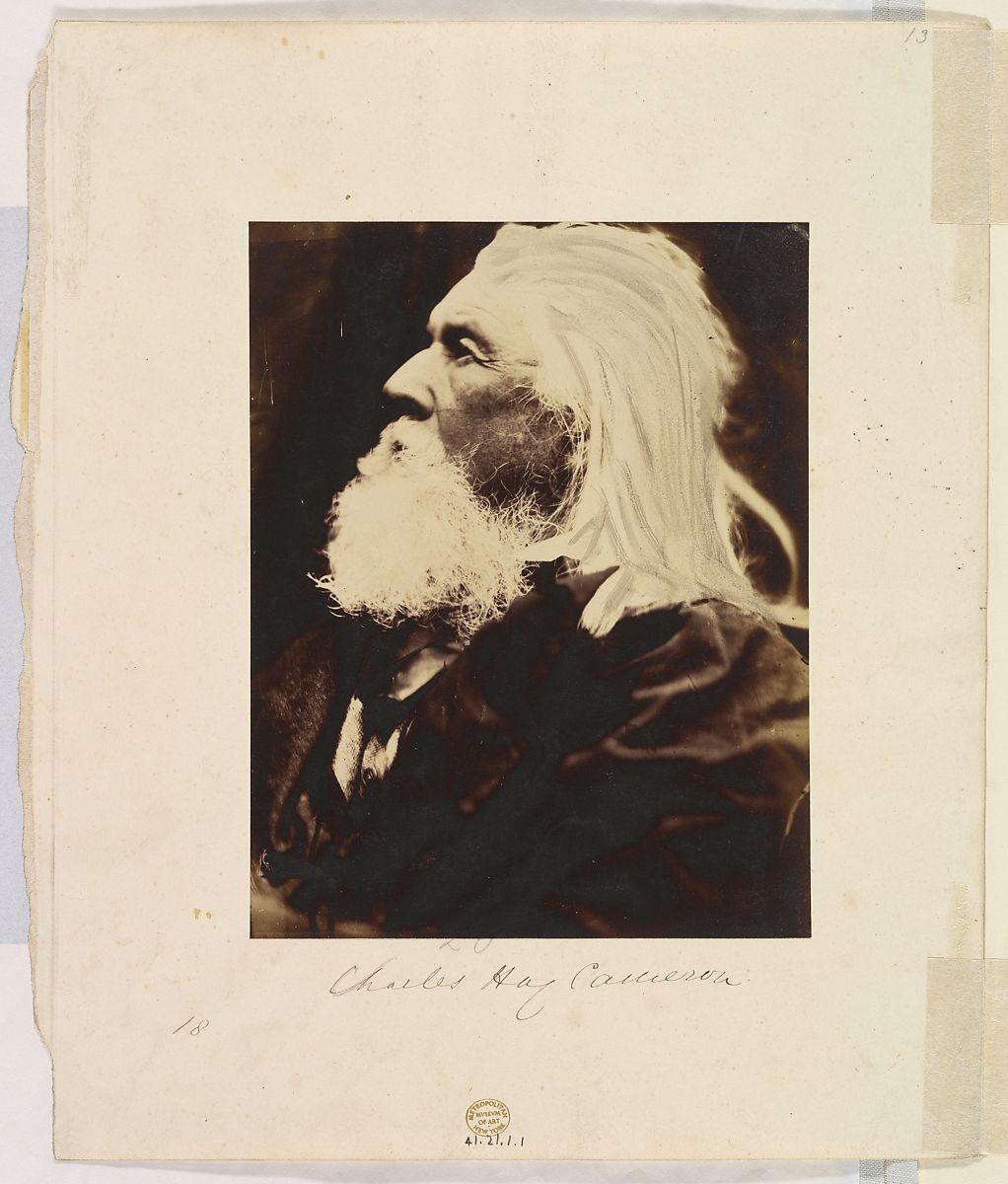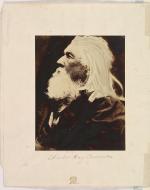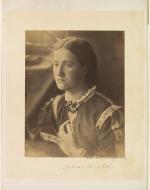Created by Maya Parekh on Fri, 10/23/2020 - 12:17
Description:
Julia Margaret Cameron (born Julia Margaret Pattle) was born in Calcutta, India, in 1815 to James Pattle and Adeline de l’Etang (Green-Lewis 616). Cameron’s parents both grew up in colonized communities in India, giving them bourgeois status even though they had little wealth (Detjen 58). Cameron married her husband, Charles Hay Cameron in 1838 in Calcutta. They had six biological children, took care of five orphaned children to whom they were related, and had one foster child (Detjen 61). Hay was 20 years older than her and a lawyer, which allowed them a privileged position within Anglo-Indian society (Green-Lewis). Hay’s position as a lawyer for the Council of Education for Bengal in the colonial administration made it possible for him to buy coffee and rubber plantations as a secondary income (Detjen 60). The Camerons moved into their home Dimbola Lodge, located on the Isle of Wight, and island off the coast of England, in 1860. Before becoming a photographer, Cameron would collect photographs and create photo albums with them (Green-Lewis 615). Cameron received her first camera from her daughter and son-in-law when she was 48 (Kennedy et al 164). Although they intended for her to use the camera as a form of entertainment, Cameron started her photography career in an effort to make extra money. However, she also described the camera “as a substitute for her absent family”, which may relate to her daughter getting married and her children growing older in general (Witcher 208). Maternity and the home were very important to Cameron, which would later be reflected in her portraits of women and mothers (Witcher 209). The money that was made from the coffee and rubber plantations was intended to be used for the Cameron’s retirement in England, but a fungus killed their plants and took a heavy toll on their finances and the Camerons needed more money to finance their boys’ educations (Detjen 64). However, photography became Cameron’s main focus in her life (Kennedy et al 164).
Cameron used her house, Dimbola, as a photography studio from 1860-1874, using her maids as models and assistants and asking her friends and loved ones to pose for her photographs, such as her husband and her close friend Sir John Herschel’s relative, Julia Herschel. Cameron and her husband often had guests staying at their house for extended periods of time, many of whom would be featured in her portraits. Over this period of time, Cameron took approximately 1200 photos–considered one of the most rare and remarkable collections produced by an amateur woman-photographer–which are now housed in museums in the United Kingdom and the United States (Detjen 57). The idea of “the home” was very important to Cameron, as she referred to her house as the starting point of her “new labour” in a memoir, in addition to the idea that having spare time and the freedom for women to pursue passions was distinctly linked with the “bourgeois home” (Detjen 58-60). Cameron would have her sitters pose for long much longer periods of time, about 3-8 minutes, and adjusted the camera’s focus to create a bit of a blur, which was often viewed negatively by critics (Kennedy et al 164). Her photographs were not focused on precision like most other Pre-Raphaelite artworks and are now considered innovative (Witcher 212). This was not the only expectation to which Cameron did not conform. She also took her maids with her to her exhibitions and challenged feminine docility by demanding her own space for photography within the home (Detjen 71). However, she still affirmed the power dynamics between mistress and maid, particularly with the way she allowed her maids to assist her, but not model as holy figures (Detjen 65).
In 1875, the Camerons were forced to leave Dimbola because they could not afford to continue living in England (Detjen 70). Cameron was unable to substantially profit from her photography, due to both less appreciation for her photos than they are today and her tendencies to give much of her work away for free and to not accept clients she didn’t know to pose for her out of pride (Green-Lewis 616). Just before the Camerons moved to their other property in the British colony of Ceylon, today known as Sri Lanka, Cameron wrote a poem entitled “On a Portrait”, in which she discussed the role of beauty in photography (Witcher 206). Their property in Ceylon was run by their eldest sons. Here, Cameron would take photographs of nature and people, but only on occasion. In January of 1879, Julia Margaret Cameron passed away in Ceylon after falling sick (Green-Lewis).
Works Cited
Detjen, Alice. “Transforming the House: The Photography of Julia Margaret Cameron.” Housing Capital, 2017, pp. 56–71., doi:10.1515/9783110532241-004.
Green-Lewis, Jennifer. “From Life: The Story of Julia Margaret Cameron and Victorian Photography (Review).” Biography, vol. 27, no. 3, 2004, pp. 613–617., doi:10.1353/bio.2004.0065.
Kennedy, Nora W., et al. “A Hidden Photograph by Julia Margaret Cameron.” Metropolitan Museum Journal, vol. 53, 2018, pp. 162–171., doi:10.1086/701748.
Witcher, Heather Bozant. “‘Art of the Future’: Julia Margaret Cameron's Poetry, Photography, and Pre-Raphaelitism.” Victorian Studies, vol. 61, no. 2, 2019, p. 204., doi:10.2979/victorianstudies.61.2.04.
Images Cited
Cameron, Julia Margaret. “Charles Hay Cameron.” The Metropolitan Museum of Art, www.metmuseum.org/art/collection/search/268697.
Cameron, Julia Margaret. “Julia Herschel.” The Metropolitan Museum of Art, www.metmuseum.org/art/collection/search/268697.



